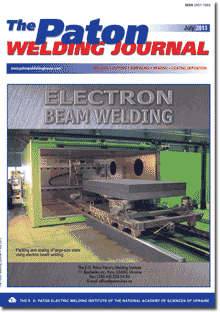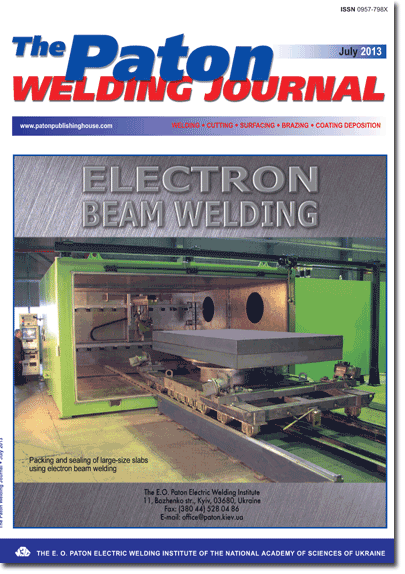
The Paton Welding Journal, 2013, #7, 44-49 pages
E.O. Paton Electric Welding Institute, NASU. 11 Bozhenko Str., 03680, Kiev, Ukraine. E-mail: office@paton.kiev.ua
Abstract
Titanium alloys are perspective materials for different branches of industry. Appearance of new high-strength materials, in particular intermetallic alloys, provides for increasing interest to processes of their joining by brazing methods. Meanwhile, the most wide spread brazing filler metals (Ti-Cu-Ni and Ti-Zr-Cu-Ni systems) developed decades ago do not always correspond to current requirements, as, for example, in brazing of intermetallic alloys. Present work provides the results of complex investigations of brazing filler metals of Ti-Zr-Fe, Ti-Zr-Mn and Ti-Zr-Co systems using differential thermal analysis, light and scanning microscopy, X-ray microspectrum analysis. Data on melting ranges of pilot alloys were obtained, and liquidus surfaces of given systems using simplex-lattice method were build. Brazing filler metals covering brazing temperature range of current structural titanium materials based on solid solutions as well as intermetallics were proposed. Structure, chemical inhomogeniety and strength characteristics of brazed joints were studied. It is determined that brazing of solid solution based alloys (OT4, VT6) using indicated brazing filler metals ensures strength characteristics of joints, which are not inferior to that obtained with application of known brazing filler metals. Proposed brazing filler metals provide strength on the level of base metal at room and elevated temperature as well as in creep-rupture testing during brazing of g-TiAl intermetallic based alloy. 13 Ref., 4 Tables, 8 Figures.
Keywords: vacuum brazing, titanium alloys, intermetallic alloys, brazing filler metals, brazed joints, structure, strength of brazed joints
Received: 06.06.13
Published: 28.07.13
References
1. Shapiro, A.E., Rabinkin, A. (2003) State of the art and new potential aerospace applications of titanium-based brazing filler metals: Overview. Welding J., 82(10), 36-43.
2. VIAM. Aircraft materials. Braze filler metals. http://viam.ru/index.php&id_page=51
3. Matsu, K. (2006) Titanium brazing for manufacturing titanium heat exchangers. In: Proc. of 3rd Int. Brazing and Soldering Conf. (April 24-26, 2006, San Antonio, USA). Materials Park: ASM Int., 307-309.
4. (2003) Handbook on brazing. Ed. by I.E. Petrunin. Moscow: Mashinostroenie.
5. Schwartz, M.M. (1987) Brazing. Materials Park: ASM Int.
6. Chorunov, V.F. (2008) Brazing of high-temperature creep-resistant alloys based on nickel and titanium. Biuletyn Institutu Spawalnictwa w Gliwicach, 5, 93-99.
7. Khorunov, V.F., Maksymova, S.V., Zelinskaya, G.M. (2010) Investigation of structure and phase composition of alloys based on the Ti-Zr-Fe system. The Paton Welding J., 9, 9-14.
8. Khorunov, V.F., Maksymova, S.V., Voronov, V.V. (2013) Investigation of alloys of Ti-Zr-Co system and their use as the brazing filler metals. Svarochn. Proizvodstvo, 2, 29-33.
9. (1990) Binary alloy phase diagrams. Ed. by T.B. Massalski. Materials Park: ASM Int.
10. Zedgenidze, I.G. (1976) Planning of experiment for study of multicomponent systems. Moscow: Nauka.
11. Scheffe, H. (1958) Experiments with mictures. J. Roy. Statist. Soc., B, 20(2), 334.
12. Maksymova, S.V. (2009) Formation of brazed joints on titanium aluminide. The Paton Welding J., 3, 2-7.
13. Khorunov, V.F., Maksymova, S.V. (2007) Structure and properties of intermetallic alloys brazed joints. In: Proc. of Int. Welding Conf. (Hefei, China, Oct. 2007), 348-352.
AS = «Automatic Welding» - 6 issues per year;
TPWJ = «PATON WELDING JOURNAL» - 12 issues per year;
SEM = «Electrometallurgy Today» - 4 issues per year;
TDNK = «Technical Diagnostics and Non-Destructive Testing» - 4 issues per year.
| 2013 №07 (06) | 2013 №07 (08) |

The Paton Welding Journal, 2013, #7, 44-49 pages
BRAZING FILLER METALS OF Ti-Zr-(Fe, Mn, Co) SYSTEM FOR BRAZING OF TITANIUM ALLOYS
V.F. KHORUNOV, S.V. MAKSYMOVA and V.V. VORONOV
E.O. Paton Electric Welding Institute, NASU. 11 Bozhenko Str., 03680, Kiev, Ukraine. E-mail: office@paton.kiev.ua
Abstract
Titanium alloys are perspective materials for different branches of industry. Appearance of new high-strength materials, in particular intermetallic alloys, provides for increasing interest to processes of their joining by brazing methods. Meanwhile, the most wide spread brazing filler metals (Ti-Cu-Ni and Ti-Zr-Cu-Ni systems) developed decades ago do not always correspond to current requirements, as, for example, in brazing of intermetallic alloys. Present work provides the results of complex investigations of brazing filler metals of Ti-Zr-Fe, Ti-Zr-Mn and Ti-Zr-Co systems using differential thermal analysis, light and scanning microscopy, X-ray microspectrum analysis. Data on melting ranges of pilot alloys were obtained, and liquidus surfaces of given systems using simplex-lattice method were build. Brazing filler metals covering brazing temperature range of current structural titanium materials based on solid solutions as well as intermetallics were proposed. Structure, chemical inhomogeniety and strength characteristics of brazed joints were studied. It is determined that brazing of solid solution based alloys (OT4, VT6) using indicated brazing filler metals ensures strength characteristics of joints, which are not inferior to that obtained with application of known brazing filler metals. Proposed brazing filler metals provide strength on the level of base metal at room and elevated temperature as well as in creep-rupture testing during brazing of g-TiAl intermetallic based alloy. 13 Ref., 4 Tables, 8 Figures.
Keywords: vacuum brazing, titanium alloys, intermetallic alloys, brazing filler metals, brazed joints, structure, strength of brazed joints
Received: 06.06.13
Published: 28.07.13
References
1. Shapiro, A.E., Rabinkin, A. (2003) State of the art and new potential aerospace applications of titanium-based brazing filler metals: Overview. Welding J., 82(10), 36-43.
2. VIAM. Aircraft materials. Braze filler metals. http://viam.ru/index.php&id_page=51
3. Matsu, K. (2006) Titanium brazing for manufacturing titanium heat exchangers. In: Proc. of 3rd Int. Brazing and Soldering Conf. (April 24-26, 2006, San Antonio, USA). Materials Park: ASM Int., 307-309.
4. (2003) Handbook on brazing. Ed. by I.E. Petrunin. Moscow: Mashinostroenie.
5. Schwartz, M.M. (1987) Brazing. Materials Park: ASM Int.
6. Chorunov, V.F. (2008) Brazing of high-temperature creep-resistant alloys based on nickel and titanium. Biuletyn Institutu Spawalnictwa w Gliwicach, 5, 93-99.
7. Khorunov, V.F., Maksymova, S.V., Zelinskaya, G.M. (2010) Investigation of structure and phase composition of alloys based on the Ti-Zr-Fe system. The Paton Welding J., 9, 9-14.
8. Khorunov, V.F., Maksymova, S.V., Voronov, V.V. (2013) Investigation of alloys of Ti-Zr-Co system and their use as the brazing filler metals. Svarochn. Proizvodstvo, 2, 29-33.
9. (1990) Binary alloy phase diagrams. Ed. by T.B. Massalski. Materials Park: ASM Int.
10. Zedgenidze, I.G. (1976) Planning of experiment for study of multicomponent systems. Moscow: Nauka.
11. Scheffe, H. (1958) Experiments with mictures. J. Roy. Statist. Soc., B, 20(2), 334.
12. Maksymova, S.V. (2009) Formation of brazed joints on titanium aluminide. The Paton Welding J., 3, 2-7.
13. Khorunov, V.F., Maksymova, S.V. (2007) Structure and properties of intermetallic alloys brazed joints. In: Proc. of Int. Welding Conf. (Hefei, China, Oct. 2007), 348-352.
The cost of subscription/purchase order journals or individual articles
| Journal/Currency | Annual Set | 1 issue printed |
1 issue |
one article |
| AS/UAH | 1800 UAH | 300 UAH | 300 UAH | 150 UAH |
| AS/USD | 192 $ | 32 $ | 26 $ | 16 $ |
| AS/EUR | 180 € | 30 € | 25 € | 15 € |
| TPWJ/UAH | 7200 UAH | 600 UAH | 600 UAH | 280 UAH |
| TPWJ/USD | 384 $ | 32 $ | 26 $ | 16 $ |
| TPWJ/EUR | 360 € | 30 € | 25 € | 15 € |
| SEM/UAH | 1200 UAH | 300 UAH | 300 UAH | 150 UAH |
| SEM/USD | 128 $ | 32 $ | 26 $ | 16 $ |
| SEM/EUR | 120 € | 30 € | 25 € | 15 € |
| TDNK/UAH | 1200 UAH | 300 UAH | 300 UAH | 150 UAH |
| TDNK/USD | 128 $ | 32 $ | 26 $ | 16 $ |
| TDNK/EUR | 120 € | 30 € | 25 € | 15 € |
AS = «Automatic Welding» - 6 issues per year;
TPWJ = «PATON WELDING JOURNAL» - 12 issues per year;
SEM = «Electrometallurgy Today» - 4 issues per year;
TDNK = «Technical Diagnostics and Non-Destructive Testing» - 4 issues per year.

